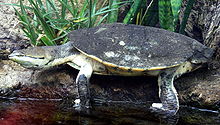|
Às vezes chamados de sapos barbudos, mas mais conhecido pelo nome científico de Phrynops, esse gênero de tartarugas costuma ser uma espécie de lixeira para as tartarugas sul-americanas de pescoço curto da família Chelidae.
O gênero é amplamente distribuído na América do Sul encontrado no Orinoco ao Amazonas e São Francisco ao Paraná e bacias fluviais adjacentes da Colômbia, Venezuela, Guianas, Brasil, Paraguai, Uruguai e nordeste da Argentina (Iverson, 1992).[5]
Essas grandes tartarugas de rio geralmente alcançam a termorregulação por meio do frade em área. Para melhor atingir seu objetivo, eles tendem a aumentar seu tempo de sol durante o meio-dia durante os invernos para compensar o frio. Outros fatores, como ingestão de alimentos e reprodução subaquática, também influenciam a maneira como controlam a temperatura do corpo. Embora essa seja a principal forma de manter a temperatura corporal, a ingestão alimentar e as taxas de reprodução também influenciam no assunto.
Espécies
Espécies vivas e fósseis atualmente reconhecidas[6]
Referências
- ↑ Wagler, J. 1830. Natürliches System der Amphibien, mit vorangehender Classification der Säugthiere und Vögel. Ein Beitrag zur vergleichenden Zoologie. Munich, Stuttgart, and Tübingen: J.G. Cotta. vi + 354 pp. + 9 plates. (in German and Latin).
- ↑ Turtle Taxonomy Working Group [van Dijk, P.P., Iverson, J.B., Rhodin, A.G.J., Shaffer, H.B., and Bour, R.]. 2014. Turtles of the World, 7th edition: annotated checklist of taxonomy, synonymy, distribution with maps, and conservation status. In: Rhodin, A.G.J., Pritchard, P.C.H., van Dijk, P.P., Saumure, R.A., Buhlmann, K.A., Iverson, J.B., and Mittermeier, R.A. (Eds.). Conservation Biology of Freshwater Turtles and Tortoises: A Compilation Project of the IUCN/SSC Tortoise and Freshwater Turtle Specialist Group. Chelonian Research Monographs 5(7):000.329–479, doi:10.3854/ crm.5.000.checklist.v7.2014.
- ↑ Gray, J.E. 1872. On Spatulemys Lasalæ, a new genus of Hydraspidæ from Rio Parana, Corrientes. Annals and Magazine of Natural History, Fourth Series 10: 463.
- ↑ Wieland, George R. 1923. A new Paraná pleurodiran. American Journal of Science, Series 5, 5: 1–14.
- ↑ lverson, J.B. 1992. Revised Checklist with Distribution Maps of the Turtles of the World. Richmond, Indiana: Privately Printed. 363 pp.
- ↑ Phrynops, The Reptile Database
- ↑ Schweigger, Augustus F. 1812. "Prodromus monographiae Cheloniorum ". Königsberger Archiv für Naturwissenschaft und Mathematik 1:271–368, 406–462.
- ↑ Duméril, André Marie Constant, and Bibron, Gabriel. 1835. Erpétologie Générale ou Histoire Naturelle Complète des Reptiles. Tome Second. Paris: Roret. 680 pp.
- ↑ Peters, Wilhem Carl Hartwig. 1870. "Über Platemys tuberosa, eine neue Art von Schildkröte aus British-Guiana ". Monatsber. königl. Akad. Wiss. Berlin. 1870 (Mai): 311-313.
- ↑ Rhodin, Anders G.J., and Mittermeier, Russell A. 1983. Description of Phrynops williamsi, a new species of chelid turtle of the South American P. geoffroanus complex. pp. 58-73. In: Rhodin, A.G.J., and Miyata, K. (Editors). 1983. Advances in Herpetology and Evolutionary Biology. Essays in Honor of Ernest E. Williams. Cambridge, Massachusetts: Museum of Comparative Zoology.
- ↑ Wieland, George R. 1923. A new Parana pleurodiran. American Journal of Science (5) v: 1-14.
- ↑ Phrynops at Fossilworks.org
Ligações externas
|
